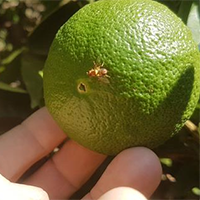Priority Area 2: Management of established fruit fly – An integrated approach is key to fruit fly control
 Fruit fly is a constant threat to Australian growers, and more importantly, Australia’s $2.7 billion horticulture export industries. An integrated pest management strategy, from farm gate to fallen fruit removal, is essential to control fruit fly in commercial orchards.
Fruit fly is a constant threat to Australian growers, and more importantly, Australia’s $2.7 billion horticulture export industries. An integrated pest management strategy, from farm gate to fallen fruit removal, is essential to control fruit fly in commercial orchards.
A combination of surveillance trapping, bait spraying, male annihilation and good farm hygiene is recommended to limit the risk of invasion.
According to Dr Bernie Dominiak, New South Wales Department of Primary Industries (NSW DPI), the simplest and most effective measure that fruit growers can take, is to place biosecurity signs on their fences.
“The first line of defence should be to make every visitor contact the property manager and declare any fruit before they are allowed over the boundary,” he says.
The natural dispersal distance of fruit flies is several hundred metres but long distance movement occur with human assistance. Typically, this might be casual labourers or friends and family.
Planning: start the season well
In regions where fruit fly is already endemic, effective management requires monitoring movement, killing active flies, and denying females a place to lay their eggs.
Dr Dominiak says refreshing trap lures as fruit flies become more active is the best start to a successful monitoring program.
“Refreshing the wicks at the start of spring, in early summer and heading into autumn targets fruit fly activity. The cue-lure wicks in traps need to be replaced several times a year to maintain maximum effectiveness.”
Trapping: monitor fruit fly pressure
Traps require diligent management since they are used as a fruit fly monitoring tool. They need to be checked frequently and a record of fruit fly numbers for each trap must be kept.
Dan Papacek, Entomologist and Director of Bugs for Bugs, advises growers to deploy the minimum traps needed to get a picture of the fruit fly population on their property. He says managing too many traps can become a time-consuming chore, and the monitoring program will suffer as a result.
“Growers should keep a regular record of each trap’s fly numbers from week to week, so changes in the population can be noted and traced to a specific trap,” he says.
“If you have a trap in the southwest corner of the orchard and you see fly numbers such as 7, 5, 9, 11, from week to week, and then it suddenly spikes to 40, you’ll know there’s a fruit fly problem and you’ll know where it’s coming from.”
Attract and kill: apply protein bait sprays
Female fruit flies need to consume protein before they can sting fruit and lay their eggs. Protein bait sprays combine a protein lure with a toxicant, to lure and kill gravid females.
“Applying bait spray should be based on fruit development and not when flies appear in traps,” says Mr Papacek. “Starting early and finishing late is the best way to protect the crop and maintain downward pressure on fruit fly numbers for the following season.”
Male annihilation: reduce the population
Male Annihilation Technique (MAT) is a control strategy that aims to reduce the fruit fly population by attracting and killing male fruit flies before they can impregnate females.
MAT is an ambush strategy that targets itinerant males, so it works well as an area-wide program that includes windbreaks, driveway trees and even road or riverside trees.
Hygiene: deny flies their brood sites
Farm hygiene is another critical aspect of an integrated fruit fly control strategy. Any infested fruit needs to be removed.
More importantly, all fallen fruit should be inspected for signs of fruit fly damage. Fruit still on the tree should also be inspected for signs of infestation, and bait spraying should be increased if fruit fly evidence is found in either case.
As a final hygiene measure, all fruit needs to be stripped out at harvest to ensure no potential fruit fly host is left hanging in the orchard. Protein bait spraying should then be continued for several more weeks, to help eradicate any fruit flies that are still active in the orchard.